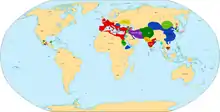AD 100
AD 100 (C) was a leap year starting on Wednesday (link will display the full calendar) of the Julian calendar. In the Roman Empire, it was sometimes referred to as year 853 ab urbe condita, i.e., 853 years since the founding of Rome in 753 B.C. The denomination AD 100 for this year has been used since the early medieval period, when the Anno Domini calendar era became the prevalent method in Europe for naming years.
| Millennium: | 1st millennium |
|---|---|
| Centuries: | |
| Decades: | |
| Years: |
| AD 100 by topic |
|---|
| Leaders |
| Categories |
|
| Gregorian calendar | AD 100 C |
| Ab urbe condita | 853 |
| Assyrian calendar | 4850 |
| Balinese saka calendar | 21–22 |
| Bengali calendar | −493 |
| Berber calendar | 1050 |
| Buddhist calendar | 644 |
| Burmese calendar | −538 |
| Byzantine calendar | 5608–5609 |
| Chinese calendar | 己亥年 (Earth Pig) 2796 or 2736 — to — 庚子年 (Metal Rat) 2797 or 2737 |
| Coptic calendar | −184 – −183 |
| Discordian calendar | 1266 |
| Ethiopian calendar | 92–93 |
| Hebrew calendar | 3860–3861 |
| Hindu calendars | |
| - Vikram Samvat | 156–157 |
| - Shaka Samvat | 21–22 |
| - Kali Yuga | 3200–3201 |
| Holocene calendar | 10100 |
| Iranian calendar | 522 BP – 521 BP |
| Islamic calendar | 538 BH – 537 BH |
| Javanese calendar | N/A |
| Julian calendar | AD 100 C |
| Korean calendar | 2433 |
| Minguo calendar | 1812 before ROC 民前1812年 |
| Nanakshahi calendar | −1368 |
| Seleucid era | 411/412 AG |
| Thai solar calendar | 642–643 |
| Tibetan calendar | 阴土猪年 (female Earth-Pig) 226 or −155 or −927 — to — 阳金鼠年 (male Iron-Rat) 227 or −154 or −926 |

The eastern hemisphere in AD 100

The world in AD 100
Events
Roman Empire
- Emperor Trajan and Sextus Julius Frontinus become Roman Consuls.
- Bricks become the primary building material in the Roman Empire.
- Pliny the Younger advances to consulship, giving his panegyric on Trajan in the process.
- The Roman Army reaches 300,000 soldiers.
- Titus Avidius Quietus' rule as governor of Roman Britain ends.
- Timgad (Thamugas), a Roman colonial town in North Africa is founded by Trajan.
- Trajan creates a policy intended to restore the former economic supremacy of Italy.
- The future emperor, Hadrian, marries Vibia Sabina.
Asia
Americas
- The Hopewell tradition begins in what is now Ohio c. this date.
- Teotihuacan, at the center of Mexico, reaches a population of 50,000.
- The Moche civilization emerges, and starts building a society in present-day Peru.
Arts and sciences
- In China, the wheelbarrow makes its first appearance.
- Main hall, Markets of Trajan, Rome, is made (until AD 112).
Religion
- Appearance of the first Christian dogma and formulas regarding morality.
- The Gospel of John is widely believed to have been written around this date.[1]
- The compilation of the Kama sutra begins in India.
- The Temple of the God of Medicine is built in Anguo, China.
- The Fourth Buddhist Council is convened c. this year.
Births
- Fa Zhen (or Gaoqing), Chinese scholar (d. 188)
- Faustina the Elder, Roman empress
- Justin Martyr, Christian apologist and saint (approximate date)
- Marcus Cornelius Fronto, Roman grammarian, rhetorician and advocate (d. 170)
- Ptolemy, Greek astrologer, astronomer, geographer and mathematician (d. 170)
- Quintus Junius Rusticus, Roman teacher and politician (approximate date)
- Quintus Tineius Sacerdos Clemens, Roman politician (approximate date)
Deaths
- Agrippa II, Jewish king of Judea (b. AD 27)
- Apollonius of Tyana, Greek philosopher (b. AD 15)
- Josephus, Jewish historian and writer (b. AD 37)
- John the Apostle of Jesus Christ (b. AD 6)
- Wang Chong, Chinese philosopher (b. AD 27)
References
- Asimov's Guide to the Bible, page 954.
This article is issued from Wikipedia. The text is licensed under Creative Commons - Attribution - Sharealike. Additional terms may apply for the media files.